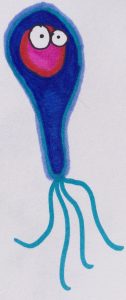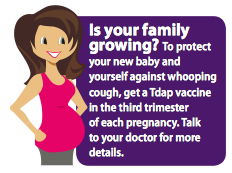Diphtheria, Tetanus, and acellular Pertussis (DTaP) Vaccine
The DTaP vaccine protects your child from getting tetanus (lockjaw), diphtheria, and acellular pertussis (whooping cough). All three of these are potentially life-threatening bacterial infections.

Tetanus
The bacteria the causes tetanus is called Clostridium tetani and is often found in the soil. In the United States, tetanus is most often transmitted through a break in the skin, such as a deep puncture, like stepping on a nail. However, injuries that involve dead skin (burns, frostbite, gangrene, crush injuries, etc.) are more likely to cause tetanus. Wounds contaminated with soil, saliva, or feces, and that are not properly cleaned, as well as punctures with non sterile needles are at an increased risk for tetanus.
Once the tetanus bacteria enters the body, it starts to release a neurotoxin (poison), which begins to attack the nervous system. Somewhere around three weeks after your child is exposed to the bacteria, you would notice your child might have a headache, become cranky, and have spasms and tightening of the jaw muscle. Sometimes the tightening in jaw, head, and neck is so extreme that the child can’t open their mouth, swallow, or even breathe, which is why this disease is often called “lockjaw”.
Following that, the neurotoxin spreads through the bloodstream and starts to interfere with the normal activity of nerves, leading to muscle spasms that could be strong enough to break your child’s bones and cause paralysis or inability to move parts of his body. Spasms can be so forceful that they tear muscles or even cause spine fractures. If left untreated, tetanus is very dangerous and can lead to death. Tetanus kills about 1 out of every 5 people infected with the bacteria.1
Neonatal tetanus is another form of tetanus that can occur in newborns are delivered in unsanitary conditions. Often times, this occurs when the bacteria enters the umbilical cord stump if the cord is not cleaned properly. This can be prevented through proper umbilical cord care, as well as through maternal vaccination while pregnant. It is recommended in the United States for mothers to get vaccinated against tetanus during every pregnancy so that antibodies can be passed to the unborn child and keep the child protected for some time after birth. Due to vaccination, neonatal tetanus is uncommon in the United States.
Tetanus in general is rare in the United States due to vaccination. Today there are fewer than 50 cases reported each year.4
The best and only way to really prevent your child from getting tetanus is though vaccination. Vaccination against tetanus should be given every ten years. Should your child get an above mentioned wound and you are unsure if he is protected or if you are unsure of when his last booster was, he must be treated immediately!
For more on tetanus and what you need to do should you think your child is in danger, click here.

Diphtheria
Diphtheria is caused by the bacteria Corynebacterium diphtheriae. It spreads very easily through the air from person to person through coughs, sneezes, and even by laughing. It can also be spread to someone who picks up tissues or drinking glasses that have been used by an infected person.
Should your child get diphtheria, he would come down with a sore throat, a mild fever (101 degrees or less), chills, and swollen neck glands. The toxin that is released by the bacteria can lead to a thick fuzzy gray or black coating in the nose, throat, or airway that can cause breathing problems and difficulty swallowing. Sometimes children may complain of double vision, have slurred speech, or even signs of going into shock (pale, cold skin, rapid heartbeat, sweating, and an anxious appearance).
Should your child have a more dangerous case of diphtheria, the toxin spreads through the bloodstream and cause life-threatening damage to other organs, such as the heart and kidneys. It also can cause nerve damage and paralysis. Up to 40% to 50% of those who have more serious cases of diphtheria and who don’t get treated may die.4 And about 1 out of 10 people who get diphtheria in general die from it.1
Children and adults who catch diphtheria will be treated in the hospital, and they will need to be isolated. Also, the health department will be notified, as well as anyone who may have come in contact with the infected person will also need to be treated.
Those who are at severe risk for infection are children under five and adults over sixty years old. Also, people living in crowded or unclean conditions, those who are under nourished, and those who remain unvaccinated are at higher risk for diphtheria infection.
The best and really the only way to prevent diphtheria is through vaccination.
Because of vaccination, diphtheria is very rare in the United States, however it is still common in developing countries.
For more information on diphtheria, click here.

Acellular Pertussis
Pertussis is also referred to as whooping cough and is caused by the bacteria Bordetella pertussis. It is very contagious and spreads easily through the air when an infected person breathes, coughs, or sneezes.
Should your child develop whooping cough, you would first notice symptoms similar to those of the common cold: runny nose, sneezing, a dry, irritating cough, and a low-grade fever. After one to two weeks, your child may develop coughing spells, which can last for more than a minute. During these spells, your child may turn red or purple. Then, at the end of the spell, your child may make a “whooping” when he breathes in or may even vomit. Between spells, the child usually feels well. The recovery time for pertussis once the child has reached the whooping stage is usually a few weeks up to a few months.
Many children who get pertussis have this characteristic cough, however, not all will. Some infants do not cough, however they may seem as if they are gasping for air. Infants with pertussis may look red in the race during these spells, and may actually stop breathing for a few seconds.
Adults and teens with whooping cough may have milder symptoms. Sometimes adults have prolonged coughs rather than coughing spells, or coughing without the whooping sound.
No matter who gets sick, all cases may lead to difficulty breathing, vomiting, and disturbed sleep. Severe cases may lead to weight loss, incontinence, and rib fractures. Up to 2 in 100 children and 5 in 100 adults with pertussis are hospitalized or have complications, which could include pneumonia or death.1

Pertussis mainly affects infants younger than six months, before they are adequately protected by vaccination, as well as in kids between 11-18 years, when the immunity is beginning to fade. Boosters are recommended for all preteens and teens due to waning immunity.
Vaccination is recommended for all infants, children, and teens.
It is recommended in the United States that all women who are pregnant get a Tdap vaccine during the second half of ALL of their pregnancies to give their newborns important antibodies to pertussis that will last some time after birth.
Before the vaccine became available, pertussis killed between 5,000 and 10,000 people in the US each year.4 Due to vaccination there are less than 30 deaths in the US each year, until recently.4 By 2004, the number of pertussis cases spiked past 25,000, the highest level it’s been since the 1950s.4 Due to the increase in unvaccinated children, in 2012 there were 48,277 reported cases of pertussis and 20 deaths in the US.1
For more information on pertussis, click here.
The TDaP Vaccine
These three diseases were rampant before the development of the vaccines against them. Before the vaccines, the US averaged around 200,000 cases of diphtheria, 175,000 cases of pertussis, and about 600 cases of tetanus per year.1 Since routine vaccination with the DTaP vaccine, the cases of tetanus and diphtheria have dropped by about 99% and pertussis by about 80%.1 However, due to increasing popularity of parents choosing not to vaccinate, the number of cases of each of these diseases is on the rise.
Currently in the United States, it is recommended that children receive five doses of the DTaP vaccine to avoid getting these three bacterial diseases. The doses are at 2 months old, 4 months old, 6 months old, between 15-18 months old, and between 4-6 years old.
Since immunity wears off to these three bacteria over time, boosters are recommended at ten year intervals for everyone over a lifetime.
The DTaP vaccine is given in five doses to children under the ages of 7. Following this series, the tetanus and diphtheria (Td) vaccine is recommended to all individuals every ten years. A tetanus and diphtheria vaccine with a pertussis booster, called the Tdap (not to be confused with DTaP) vaccine (which has a reduced dose of the diphtheria and pertussis vaccine), is recommended to replace one of the Td boosters any time between the ages of 11 and 64. The recommendation for this Tdap booster is between the ages of 11 and 12 years of age.
The Tdap vaccine is especially important for health care professionals, anyone caring for a baby under 12 months, and pregnant women. All pregnant women are also advised to get the Tdap vaccine, preferably between 27 and 36 weeks’ gestation. Tdap should be given during EVERY pregnancy to protect the newborn from pertussis, since newborns are most at risk for life-threatening pertussis.
Also, all children and adults who have had a severe cut or burn may need Td or Tdap to protect against tetanus infection, as well as further care. It is recommended that Tdap be given after a severe cut or burn to prevent tetanus infection.
Studies show that the two or three vaccines are perfectly safe to be given at the same time in one single vaccine: DTaP, Tdap, or Td. However, as with any medication, there are risks and slight chances of side effects due to vaccination. Mild problems, if they are to occur, happen about 1-3 days after vaccination and generally pass quickly.
The most mild common side effects include:
- Pain and swelling at the injection site (about 1 person in 5)1
- Mild fever of at least 100.4°F (1 in 25 children or 1 in 100 adults)1
- Headache (30-40% of people)1
- Tiredness (about 25% of people)1
- Nausea, vomiting, diarrhea, stomach ache (25% of children and 10% of adults)1
- Chills, body aches, sore joints, rash, swollen glands (uncommon)
More moderate problems (no need for medical attention) include:
- Pain where the shot was given (about 1 in 5 children or 1 in 100 adults)1
- Redness or swelling where the shot was given (up to about 1 in 16 children or 1 in 25 adults)1
- Fever over 102°F (about 1 in 100 children or 1 in 250 adults)1
- Headache (about 3 in 20 children or 1 in 10 adults)1
- Nausea, vomiting, diarrhea, stomach ache (up to 1 or 3 people in 100)1
- Swelling of the entire arm where the shot was given (up to about 3 in 100)1
The risk of experiencing a severe problem to DTaP or Tdap is extremely rare. Severe problems include:
- Swelling
- Severe pain
- Bleeding and redness in the arm where the shot was given (rare)
- Severe allergic reactions, which could occur after any vaccine (estimated less than 1 in a million doses)1
An allergic reaction is one of the most serious problems that can occur with getting any vaccine. What to do if your child has a serious reaction to a vaccine.
Very rare reactions have been reported for the DTaP vaccine, such as long-term seizures, coma, lowered consciousness, and brain damage. These are so rare that the CDC says it’s impossible to tell whether they were actually related to the vaccine or caused by something else.1
There is also no proof that DTaP, Tdap, or Td is linked to the development of autism.
The CDC recommends that children who are ill with anything other than a cold at the time they are scheduled to receive the vaccine should wait until they are better before getting it. It is safe to get the vaccine if your child has a cold or low-grade fever.3
Parents of children with epilepsy, any other nervous system problem, or have ever had Guillain-Barré Syndrome (GBS) should discuss vaccine options with their doctor.
If your child has had a bad reaction to the DTaP vaccine, he should not receive another dose. However, he may be able to receive the Td vaccine or Tdap vaccine. Discuss your child’s options with your doctor.
Your child should not get a second dose of the DTaP vaccine if your child:
- Had a life-threatening allergic reaction to DTaP
- Has suffered a brain or nervous system disease within seven days of receiving DTaP
- Had a seizure or collapsed after a dose of DTaP
- Cried nonstop for 3 hours or more after a dose of DTaP
- Had a fever over 105* F after a dose of DTaP
There is no vaccine that works 100% of the time. There is always a chance, however rare, that even after getting the vaccine, your child may still get sick with one of these bacterial infections. However, the vaccine always lessens the severity of the disease.
All three of these bacterial infections are serious and life-threatening. The risk of your child contracting diphtheria, tetanus, or pertussis is high without the vaccine. Due to the increase in parents choosing not to vaccinate their children, these diseases are on the rise. It is important to remember that by keeping your child’s vaccines up to date, you can protect not only your children, but the entire community from serious illness.
Resources:
- Centers for Disease Control and Prevention (CDC). www.cdc.gov
- Medline Plus.US National Library of Medicine. National Institutes of Health. www.nlm.nih.gov
- WebMD. www.webmd.com
- Kids Health. Nemours. www.kidshealth.org
- National Network for Immunization Information. www.immunizationinfo.org

